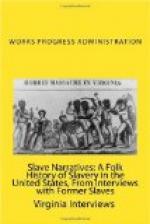“No, dere wa’nt no jails, but a guard house. When niggers did wrong, dey was oft’n sent dere, but mos’ allus dey was jes whupped when too lazy to wuk, an’ when dey would steal.
“Our clo’es was all wove and made on de plan’ation. Our ever’day ones, we called ‘hick’ry strips.’ We had a’ plen’y er good uns. We was fitted out an’ out each season, an’ had two pairs of shoes, an’ all de snuff an’ ’bacco we wanted every month.
“No, not any weddin’s. It was kinder dis way. Dere was a good nigger man an’ a good nigger woman, an’ the Marster would say, ’I knows you both good niggers an’ I wants you to be man an’ wife dis year an’ raise little niggers; den I won’t have to buy’ em.’
“Marse Bob lived in a big white house wid six rooms. He had a cou’t house an’ a block whar he hired out niggers, jes like mules an’ cows.
“How many slaves did us have? Les’ see. Dere was old Lady Sally an’ her six chullun an’ old Jake, her husban’, de ox driver, fer de boss. Den dere was old Starlin’, Rose, his wife an’ fo’ chullun. Some of dem was mixed blood by de oberseer. I sees ’em right now. I knowed de oberseer was nothin’ but po’ white trash, jes a tramp. Den dere was me an’ Katherin. Old Lady Sally cooked for de oberseers, seven miles ’way frum de Big House.
“Ever’body was woke up at fo’ o’clock by a bugle blowed mos’ly by a nigger, an’ was at dey work by sun-up. Den dey quits at sunset. I sho’ seed bad niggers whupped as many times as dere is leaves on dat groun’. Not Marse Bob’s niggers, but our neighbors. We was called ‘free,’ ’cause Marse Bob treated us so good. The whuppin’ was done by de oberseer or driver, who would say as he put de whup to de back, ’Pray sir, pray sir!’
“I seed slaves sol’ oft’ener dan you got fingers an’ toes. You know I tol’ you dere was a sellin’ block close to our sto’. Den plen’y niggers had to be chained to a tree or post ’cause he would run ‘way an’ wouldn’ wuk.
“Dey would track de runways wid dogs an’ sometimes a white scal’wag or slacker wud be kotched dodgin’ duty. I seed as many deserters as I see corn stalks ober in dat fiel’. Dey would hide out in day time an’ steal at night.
“No’m I didn’ learn to read an’ write but my folks teached me to be honest an’ min’ Old Miss an’ Granny. Dey didn’ want us to learn how to go to de free country.
“We had a neighborhood chu’ch an bofe black an’ white went to it. Dere was a white preacher an’ sometimes a nigger preacher would sit in de pulpit wid him. De slaves set on one side of de aisle an’ white folks on de other. I allus liked preacher Williams Odem, an’ his brudder Daniel, de ‘Slidin’ Elder’.[FN: back slider] Dey come frum Ohio. Marse Bob Allen was head steward. I’ members lots of my fav’rite songs. Some of dem was, Am I born to Die, Alas and Did my Savior Bleed, an’ Must I to de Judgment be Brought. The preacher would say ’Pull down de line and let de spirit be a witnes, workin’ fer faith in de future frum on high.’




